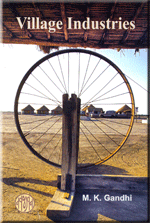
P.O. SEVAGRAM, DIST.WARDHA 442102, MS, INDIA. Phone: 91-7152-284753
FOUNDED BY MAHATMA GANDHI IN 1936
Village Industries

VILLAGE INDUSTRIES
Written by :M. K. Gandhi
Table of Contents
- Why The Village Industries Movement
- Causes of Decline of Village Industries
- Dangers of Mechanization
- Rehabilitation of Village Industries
- Difficulties in The Way
- Pattern of State Assistance
- Spinning Wheel : The Life-Giving Sun
- Tanning
- Dairying
- Gur and Khandsari
- Other Village Industries
- Village Exhibitions
About This Book
Written by : M. K. Gandhi
Edited by : Bharatan Kumarappa
First Edition : 10,000 copies, April 1960
I.S.B.N : 81-7229-121-3
Printed and Published by : Jitendra T. Desai
Navajivan Mudranalaya,
Ahmedabad - 380 014,
India.
© Navajivan Trust, 1960
Download
Chapter-5: Difficulties in The Way
My difficulties are two. One is whether it is possible to sell hand-made articles as cheaply as machine-made ones. The second is that out of the articles that have been enumerated in the scheme there is hardly any except Khadi which can become universal. They will not, in a large measure, be consumed locally and so will have to be sold in the cities. This is as it should be. The villagers should, develop such a high degree of skill that articles prepared by them should command a ready market outside. When our villages are fully developed there will be no dearth in them of men with a high degree of skill and artistic talent. There will be village poets, village artists, village architects, linguists and research workers. In short there will be nothing in life worth having which will not be had in the villages. Today the villages are dung heaps. Tomorrow they will be like tiny gardens of Eden where dwell highly intelligent folk whom no one can deceive or exploit.
The reconstruction of the villages along these lines should begin right now. That might necessitate some modification of the scheme. The reconstruction of the villages should not be organized on a temporary but permanent basis.
My second difficulty is that in the scheme under question, craft and education have been divorced from each other. Graft, art, health and education should all be integrated into one scheme. Nai Talim is a beautiful blend of all the four and covers the whole education of the individual from the time of conception to the moment of death. Therefore, I would not divide village uplift work into watertight compartments from the very beginning but undertake an activity which will combine all four. Instead of regarding craft and industry as different from education, I will regard the former as the medium for the latter. Nai Talim ought to be integrated into the scheme.
Harijan, 10-11-1946
"Begin with Yourself"
Correspondents have been writing, and friends have been seeing me, to ask me how to begin the village industries work and what to do first.
The obvious answer is, "Begin with yourself and do first that which is easiest for you to do."
This answer, however, does not satisfy the enquirers. Let me, therefore, be more explicit.
Each person can examine all the articles of food, clothing and other things that he uses from day to day and replace foreign makes or city makes, by those produced by the villagers in their homes or fields with the simple inexpensive tools they can easily handle and mend. This replacement will be itself, an education of great value and a solid beginning. The next step will be opened out to him of itself. For instance, say, the beginner has been hitherto using a tooth-brush made in a Bombay factory. He wants to replace it with a village brush. He is advised to use a babul twig. If he has weak teeth or is toothless, he has to crush one end of it, with a rounded stone or a hammer, on a hard surface. The other end he slits with a knife and uses the halves as tongue-scrapers. He will find these brushes to be cheaper and much cleaner than the very unhygienic factory-made toothbrush. The city-made tooth-powder he naturally replaces with equal parts of clean, finely-ground, wood-charcoal and clean salt. He will replace mill-cloth with village-spun Khadi, and mill-husked rice with hand-husked, unpolished rice, and white sugar with village-made gur. These I have taken merely as samples already mentioned in these columns. I have mentioned them again to deal with the difficulties that have been mentioned by those who have been discussing the question with me.
Harijan, 25-1-1935